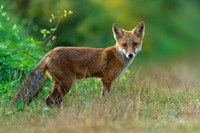East Gippsland Landcare Network
Biodiversity monitoring
Landcare
Traditionally, identification of individuals requires intensive trapping and tagging methods while dietary analyses is limited to what can be visually identified from scat or gut contents. These methods can be highly invasive, costly and time consuming. By applying eDNA techniques these outcomes can be achieved more effectively and without having to physically interfere with the species.
EGLN utilised fox detection dogs to collect 103 fresh fox scats. EnviroDNA analysed samples and genotyped (using microsatellites) to identify individual foxes using a methodology developed by EnviroDNA and the Otway Conservation Ecology Centre to help understand fox densities. DNA samples were prepared into libraries and sequenced. Bioinformatic analyses identified genetic sequences against an extensive reference database to ascertain which vertebrate species are present in each sample.
In total, 23 individual foxes were identified (10 females and 13 males). Seventeen individuals were only detected from a single scat and are likely transient or fringe individuals. The remaining 6 individuals were detected more than once, likely resident animals, with one individual being detected ten times.
EnviroDNA delivered a diet analysis summary of the species detected in each scat sample. The analysis highlighted the diverse and opportunistic diet of foxes that incorporated fish, frogs, birds, mammals and reptiles (with plant and invertebrates also observed in scats). A number of species are likely to be a result of scavenging (e.g. wedge-tailed eagle, eastern grey kangaroo, Australian bass).
This study involved a particular interest in the presence of migratory shorebird species. While no migratory shorebirds were detected in the scats, this may be a result of the timing of scat collection (~90% in October). Such species may form a larger part of the foxes diet during summer when migratory birds are in much greater abundance with breeding also occurring, providing greater opportunities for predation and nest raids for eggs and chicks. In this study, East Gippsland Landcare Network were able to increase their understanding of fox density at local sites and obtain baseline data to support ongoing monitoring.
Table: A list of common names for species recorded in this survey.


